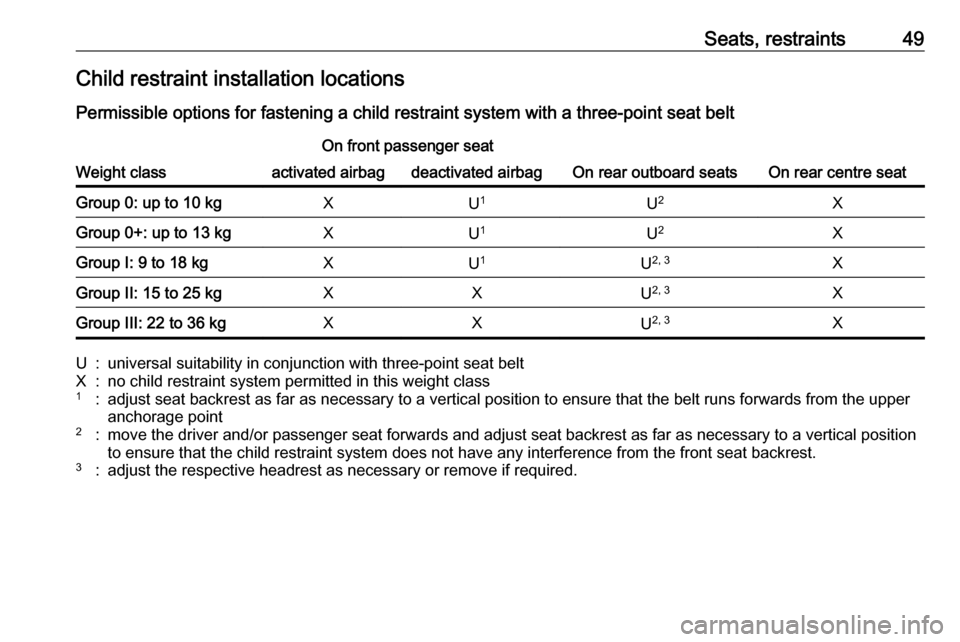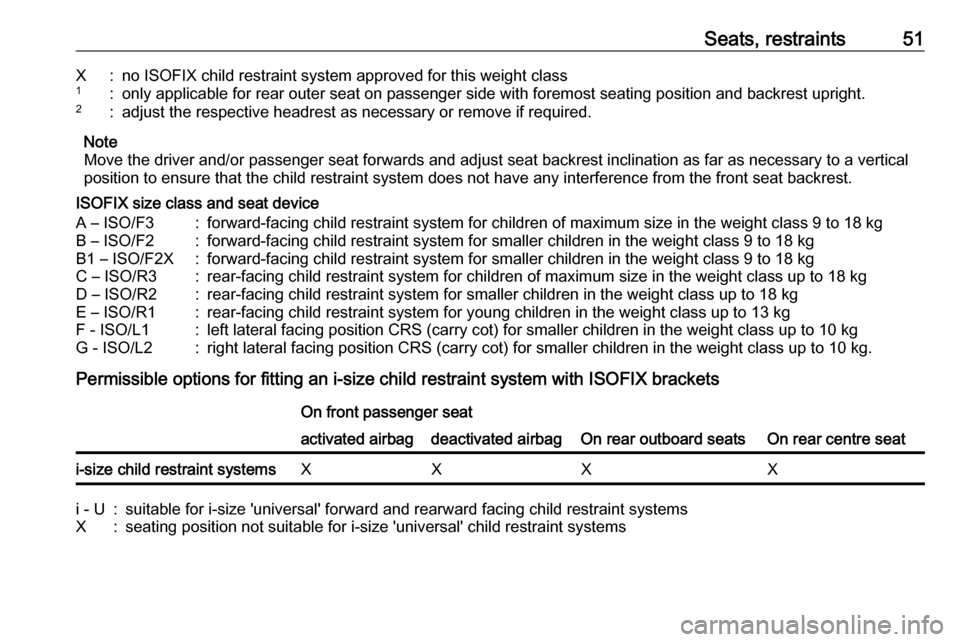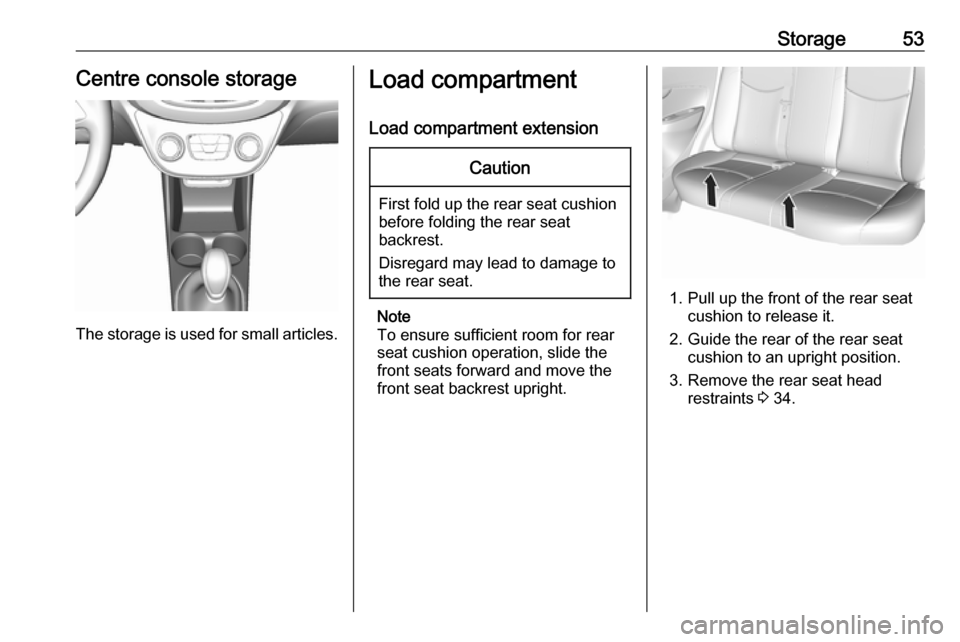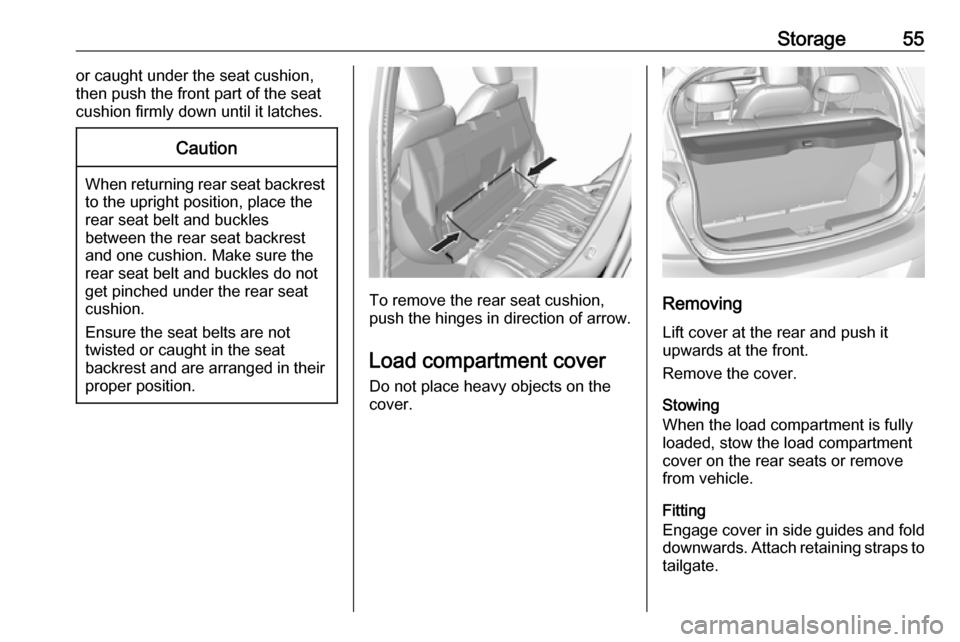remove seats OPEL KARL 2019 Manual user
[x] Cancel search | Manufacturer: OPEL, Model Year: 2019, Model line: KARL, Model: OPEL KARL 2019Pages: 191, PDF Size: 5.51 MB
Page 37 of 191

Seats, restraints35Rear head restraints, height
adjustment
Pull the head restraint upwards and
let engage. To move downwards, press the catch to release and push
the head restraint downwards.
Removal of rear head restraint
E.g. when using a child restraint
system 3 46.
Press both catches, pull the head
restraint upwards and remove.
Front seats
Seat position9 Warning
Only drive with the seat correctly
adjusted.
9 Danger
Do not sit closer than 25 cm to the
steering wheel, to permit safe
airbag deployment.
9 Warning
Never adjust seats while driving as
they could move uncontrollably.
9 Warning
Never store any objects under the
seats.
Page 49 of 191

Seats, restraints47Always comply with local or national
regulations. In some countries, the
use of child restraint systems is
forbidden on certain seats.
Child restraint systems can be
fastened with:
● Three-point seat belt
● ISOFIX brackets
● Top-tether anchor
Three-point seat belt
Child restraint systems can be
fastened by using a three-point seat
belt. After fastening the child restraint system the seat belt has to be
tightened 3 49.ISOFIX brackets
Fasten vehicle-approved ISOFIX
child restraint systems to the ISOFIX
mounting brackets. Specific vehicle
ISOFIX child restraint system
positions are marked in the table by
IL.
ISOFIX mounting brackets are
indicated by a ISOFIX label on the
backrest.
ISOFIX child restraint systems of
universal category positions are
marked in the table by IUF.
Either a Top-tether strap or a support leg must be used in addition to the
ISOFIX mounting brackets.
Remove rear head restraint before
mounting a child restraint system, if
required 3 34.
Top-tether anchors
Top-tether anchors are marked with
the symbol : for a child seat.
In addition to the ISOFIX mounting
brackets, fasten the Top-tether strap
to the Top-tether anchors.
ISOFIX child restraint systems of
universal category positions are
marked in the table by IUF 3 49.
Remove rear head restraint before
mounting a child restraint system, if
required 3 34.
Page 50 of 191

48Seats, restraintsSelecting the right systemThe rear seats are the most
convenient location to fasten a child
restraint system.
Children should travel facing
rearwards in the vehicle as long as
possible. This ensures that the child's backbone, which is still very weak, is
under less strain in the event of an
accident.
Suitable are restraint systems that
comply with valid UN ECE
regulations. Check local laws and
regulations for mandatory use of child restraint systems.
Ensure that the child restraint system to be installed is compatible with the
vehicle type.
Refer to the tables on the following
pages, the instructions supplied with
the child restraint system and the
vehicle type list of non-universal child
restraint systems.The following child restraints are
recommended for the following
weight classes:
● Group 0, Group 0+
Maxi Cosi Cabriofix with ISOFIX
base, for children up to 13 kg
● Group I
Duo Plus with ISOFIX and Top
tether, for children from 9 kg to
18 kg in this group
● Group II, Group III
Kidfix XP with or without ISOFIX
for children from 15 kg to 36 kg
Nania / OSANN Dream Booster
with or without ISOFIX for
children from 22 kg to 36 kg
Ensure that the mounting location of
the child restraint system within the
vehicle is correct, see following
tables.
Allow children to enter and exit the
vehicle only on the side facing away
from the traffic.
When the child restraint system is not in use, secure the seat with a seat belt
or remove it from the vehicle.Note
Do not affix anything on the child
restraint systems and do not cover
them with any other materials.
A child restraint system which has
been subjected to stress in an
accident must be replaced.
Page 51 of 191

Seats, restraints49Child restraint installation locations
Permissible options for fastening a child restraint system with a three-point seat belt
Weight class
On front passenger seat
On rear outboard seatsOn rear centre seat
activated airbagdeactivated airbagGroup 0: up to 10 kgXU 1U 2XGroup 0+: up to 13 kgXU1U2XGroup I: 9 to 18 kgXU1U 2, 3XGroup II: 15 to 25 kgXXU2, 3XGroup III: 22 to 36 kgXXU2, 3XU:universal suitability in conjunction with three-point seat beltX:no child restraint system permitted in this weight class1:adjust seat backrest as far as necessary to a vertical position to ensure that the belt runs forwards from the upper
anchorage point2:move the driver and/or passenger seat forwards and adjust seat backrest as far as necessary to a vertical positionto ensure that the child restraint system does not have any interference from the front seat backrest.3:adjust the respective headrest as necessary or remove if required.
Page 53 of 191

Seats, restraints51X:no ISOFIX child restraint system approved for this weight class1:only applicable for rear outer seat on passenger side with foremost seating position and backrest upright.2:adjust the respective headrest as necessary or remove if required.
Note
Move the driver and/or passenger seat forwards and adjust seat backrest inclination as far as necessary to a vertical position to ensure that the child restraint system does not have any interference from the front seat backrest.
ISOFIX size class and seat device
A – ISO/F3:forward-facing child restraint system for children of maximum size in the weight class 9 to 18 kgB – ISO/F2:forward-facing child restraint system for smaller children in the weight class 9 to 18 kgB1 – ISO/F2X:forward-facing child restraint system for smaller children in the weight class 9 to 18 kgC – ISO/R3:rear-facing child restraint system for children of maximum size in the weight class up to 18 kgD – ISO/R2:rear-facing child restraint system for smaller children in the weight class up to 18 kgE – ISO/R1:rear-facing child restraint system for young children in the weight class up to 13 kgF - ISO/L1:left lateral facing position CRS (carry cot) for smaller children in the weight class up to 10 kgG - ISO/L2:right lateral facing position CRS (carry cot) for smaller children in the weight class up to 10 kg.
Permissible options for fitting an i-size child restraint system with ISOFIX brackets
On front passenger seat
On rear outboard seatsOn rear centre seat
activated airbagdeactivated airbagi-size child restraint systemsXXXXi - U:suitable for i-size 'universal' forward and rearward facing child restraint systemsX:seating position not suitable for i-size 'universal' child restraint systems
Page 55 of 191

Storage53Centre console storage
The storage is used for small articles.
Load compartment
Load compartment extensionCaution
First fold up the rear seat cushion
before folding the rear seat
backrest.
Disregard may lead to damage to
the rear seat.
Note
To ensure sufficient room for rear
seat cushion operation, slide the
front seats forward and move the
front seat backrest upright.
1. Pull up the front of the rear seat cushion to release it.
2. Guide the rear of the rear seat cushion to an upright position.
3. Remove the rear seat head restraints 3 34.
Page 57 of 191

Storage55or caught under the seat cushion,
then push the front part of the seat
cushion firmly down until it latches.Caution
When returning rear seat backrest
to the upright position, place the
rear seat belt and buckles
between the rear seat backrest
and one cushion. Make sure the
rear seat belt and buckles do not
get pinched under the rear seat
cushion.
Ensure the seat belts are not twisted or caught in the seat
backrest and are arranged in their proper position.
To remove the rear seat cushion,
push the hinges in direction of arrow.
Load compartment cover Do not place heavy objects on thecover.Removing
Lift cover at the rear and push it
upwards at the front.
Remove the cover.
Stowing
When the load compartment is fully
loaded, stow the load compartment
cover on the rear seats or remove
from vehicle.
Fitting
Engage cover in side guides and fold
downwards. Attach retaining straps to tailgate.